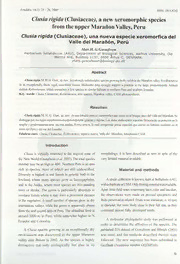Table Of Contentnew
Clusia rigida (Clusiaceae), a xeromorphic
species
from
the upper Maraiion Peru
Valley,
Clusia rigida (Clusiaceae), una nueva especie xeromorfica
del
Maranon,
Valle del Peru
CAM
Key words: Clmia, Clusiaceae, Retimstemon, new species, Maranon valley, photosynthesis.
CAM.
fotosintesis
I,
new
Clusia is virtually restricted to the tropical zone of morphology, it is here described as in spite of the
New
the World (Gustafsson et 2007). The total species veiy limited material available,
al.
number may be as high as 400. Northern Pern an area
is
rich in species, most of which are still undescribed. Material and methods
Diversity highest in wet forests in general, both in the
is
A
AAU,
lowland, where many species grow as hemiepiphytes, single collection is known, kept at herbarium
USM.
and in the Andes, where most species are free-standing with a duplicate at Only fruiting material was available,
trees or shrubs. The genus particularly abundant in Apart from field notes conceming latex color and laticifers,
is
made
montane where may form a prominent element the observations were on pressed specimens and
forests
it
mm
A
in the vegetiition. small number of species grow in diy tmits preserved in ethanol. Fmits were immature, c.
1
and of The contained almost fully developed seeds,
frotn the coastal area Peai. altitudinal limit
is
m N
somewhat
around 3000 while higher
Peru, in
in
,._,....,.
A
was
molecular phylogenetic study performed
in
order to determine the affmities of the species. The
A
species growing in an exceptionally dry published ITS dataset of Gustafsson and Bittrich (2003)
C7;/.s7c/
environment was discovered the upper Maranon was used, and the methods described therein were
in
valley near Balsas in 2002. As the species is highly followed. The new sequence has been submitted to
GenBank number GQ2445
distinctive not only ecologically but also in (Accession
its 16).
new
ion: Clufiia rigida, a species from Maranon Peru
valley,
'^
t
iranon Peru
valley,
Formal taxonomy
Leaf
laticifers visible as thin white lines on
of
ie fresh leaves, not discernible abaxially
daM.U.G
Gust.,sp. nov
(Fig.
1
rindiyh
Inflorescences three-flowered
'es. dichasia;
X
TYPE. Dept Amazonas, Prov. Chachapoyas, Valley bracts and bracteoles 2-3 2-3 mm; pedicel of terminal
km Aower mm,
of Rio Maranon, 14 from Balsas on road to c. 25 that of the lateral flowere 10 mm.
c.
mm
mm
Leimebamba Dry scmb with Shmb 2 m. Latex yeUow. Sepals four, the outer pair 5 long and wide,
cacti. c.
1
W
M
mm
7° 58 6° 53 650- 700 m. G the inner long and wide, with membranous
S. Alt. July 2002. c.
' ' 1 1 3, //. 1
AAU;
Gmtafsson 516 (Holotype: Isotype: USM). margin. Petals unknown. Fmit (immature) spherical, 10
c.
Clusia obdeltifolia similis, a qua Jloribus mm
differt
.5 tall. Stigmata 5-6, fomiing a nng at the apex of^tht
1
pedicellatis sepalis quatuor, ab speciebus generis mm
aliis ^,^
^ 2.5 long, rounded tnangular, shortly
peltate,
obdeltoideis
foliis
c A
with a small central depression. single seed per carpel
m
Description. Shrub to 2 yellow
tall v
1
Branches
terete, smooth. Termin,
mm
vegetative branches 5 wide. Leaves very
c.
stiff",
tl
mm mm
grayish green; petiole 8- 12 long, 3-7 wide; lamina known
ciusia rigida only from
a single small
is
mm mm
cuneiform, 65-100 long, 45-85 wide; secondary
population at the type locality. grows in dry open scmb
It
^^^^.^^* A^, i^„,,_ .u„ ^^„*„ „f
.,o,r,. 0/1 :jo .„ .^ *i,„
.^
^^^ ^pp^^ Maraiion an of around
valley, at altitude
45°
leaf at an angle of ca. to the mic
1700 m. This habitat one of the driest for any Clusia
is
mm
collecting vein from margin. Margin
c.
1 species, harboring succulents such as several and
cacti,
new
Gustafsson: from Maranon
Clusia rigida, a species valley, Peru
N
deciduous
as well as evergreen shrubs. This type of rigida in dry Andean valleys in Peru and S Ecuador
vegetation covers extensive region, but no other (M. As
Gustafsson, unpublished). far as knoAvn, flowers
populations were observed during travel through the produce resin and are pollinated by bees. There
is
Adaptation environment
area. to the arid is evident not considerable diversity of floral form, particularly as regards
only in the extremely thick leaves, but also in the the androecium. C/us/angz^fcr differs from other known
all
CAM
possession of pronounced photosynthesis (Klaus members of Retimstemon having few
sect. in as as five
Winter, unpublished), a trait that is expressed to very carpels and few-seeded
fruits,
varying degree in Clusia (cf contributions
in Liittge,
2^^
Acknowledgements
^
The
cuneiform ^
thick, rigid, leaves are highly ^
.... "^ ^ ^ Thank, s d,ue r^, • M. a- n.o
are to Elvira Cotton, ..Za.pat,a C.ruz
A
,,., w
distinctive. single species has leaves with similar shape, ^
^ u
,,,,,_.., and Sanchez VVeeggaa .•
^ Isidoro for invaluable help
in
C i
^
obdeltifoha Bittnch from campos rupestres of Bahia
the field work. Benjamin 011gaard kindly
ti
and Minas
Gerais
(Bittrich, 1996). belongs, h
It
the latin diagnosis. The field work was
distinguished,
e.
>
by
financed
i
s
sepals,
suuiic..-
(8)
^^5^^^
Council (SNF)
to the author.
e thick, irregularly angular stigmata.
The
of
results the molecular study strongly support
Literature cited
^''"^^^ '^'^^ "°^^^ g^"^^« Clusia
uld not be determined with ^- '^^P^'^'^^ ^'>
certainty.
^'^'^^Z
do
(Guttiferae) Brasil. Bol. Bot. Univ. Sao Paulo
15(1):
Clusia Retimstemon
sect. a large group, probably
is
th well over 100 species, with a high proportion of
^"TZl^oio^^i,":; Ll.^y^^^^^^
The
species. distribution mainly Andean, flowers of Clusia
is L. (Clusiaceae): insights from ITS
sequence
many variation. Nord. J. Bot. 22(2): 183-203.
species also in Central America and
:
Amazon Many Liittge, U. 2007. A Woody
Basin. species are endemic (ed.). Clusia. Neotropical
A
r hemiepiphytes lowland few
in forests. species
somewhat
id in habitats
similar to those of
C.

